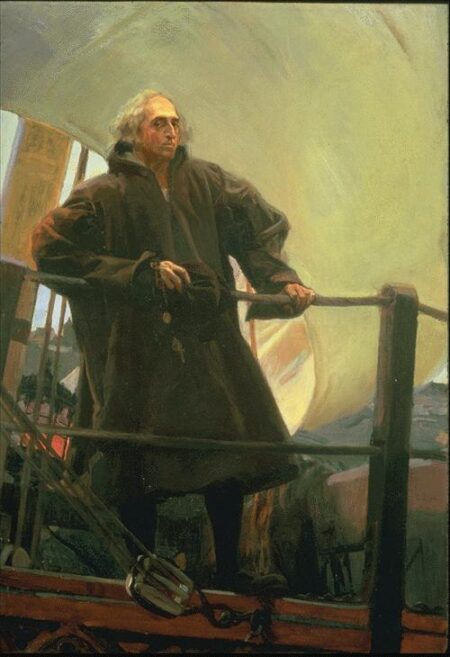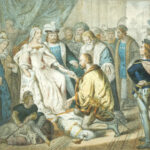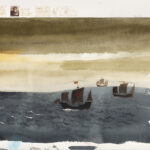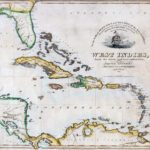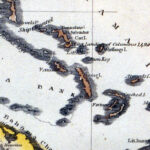Christopher Columbus
Explorer
Age of Discovery
Quick Facts:
He is credited for discovering the Americas in 1492, although we know today people were there long before him; his real achievement was that he opened the door for more exploration to a New World.
Introduction
We know that In 1492, Columbus sailed the ocean blue. But what did he actually discover? Christopher Columbus (also known as (Cristoforo Colombo [Italian]; Cristóbal Colón [Spanish]) was an Italian explorer credited with the “discovery” of the Americas. The purpose for his voyages was to find a passage to Asia by sailing west. Never actually accomplishing this mission, his explorations mostly included the Caribbean and parts of Central and South America, all of which were already inhabited by Native groups.
Biography
Early Life
Christopher Columbus was born in Genoa, part of present-day Italy, in 1451. His parents’ names were Dominico Colombo and Susanna Fontanarossa. He had three brothers: Bartholomew, Giovanni, and Giacomo; and a sister named Bianchinetta. Christopher became an apprentice in his father’s wool weaving business, but he also studied mapmaking and sailing as well. He eventually left his father’s business to join the Genoese fleet and sail on the Mediterranean Sea.1 After one of his ships wrecked off the coast of Portugal, he decided to remain there with his younger brother Bartholomew where he worked as a cartographer (mapmaker) and bookseller. Here, he married Doña Felipa Perestrello e Moniz and had two sons Diego and Fernando.
Christopher Columbus owned a copy of Marco Polo’s famous book, and it gave him a love for exploration. In the mid 15th century, Portugal was desperately trying to find a faster trade route to Asia. Exotic goods such as spices, ivory, silk, and gems were popular items of trade. However, Europeans often had to travel through the Middle East to reach Asia. At this time, Muslim nations imposed high taxes on European travels crossing through.2 This made it both difficult and expensive to reach Asia. There were rumors from other sailors that Asia could be reached by sailing west. Hearing this, Christopher Columbus decided to try and make this revolutionary journey himself. First, he needed ships and supplies, which required money that he did not have. He went to King John of Portugal who turned him down. He then went to the rulers of England, and France. Each declined his request for funding. After seven years of trying, he was finally sponsored by King Ferdinand and Queen Isabella of Spain.
Voyages
Principal Voyage
Columbus’ voyage departed in August of 1492 with 87 men sailing on three ships: the Niña, the Pinta, and the Santa María. Columbus commanded the Santa María, while the Niña was led by Vicente Yanez Pinzon and the Pinta by Martin Pinzon.3 This was the first of his four trips. He headed west from Spain across the Atlantic Ocean. On October 12 land was sighted. He gave the first island he landed on the name San Salvador, although the native population called it Guanahani.4 Columbus believed that he was in Asia, but was actually in the Caribbean. He even proposed that the island of Cuba was a part of China. Since he thought he was in the Indies, he called the native people “Indians.” In several letters he wrote back to Spain, he described the landscape and his encounters with the natives. He continued sailing throughout the Caribbean and named many islands he encountered after his ship, king, and queen: La Isla de Santa María de Concepción, Fernandina, and Isabella.
It is hard to determine specifically which islands Columbus visited on this voyage. His descriptions of the native peoples, geography, and plant life do give us some clues though. One place we do know he stopped was in present-day Haiti. He named the island Hispaniola. Hispaniola today includes both Haiti and the Dominican Republic. In January of 1493, Columbus sailed back to Europe to report what he found. Due to rough seas, he was forced to land in Portugal, an unfortunate event for Columbus. With relations between Spain and Portugal strained during this time, Ferdinand and Isabella suspected that Columbus was taking valuable information or maybe goods to Portugal, the country he had lived in for several years. Those who stood against Columbus would later use this as an argument against him. Eventually, Columbus was allowed to return to Spain bringing with him tobacco, turkey, and some new spices. He also brought with him several natives of the islands, of whom Queen Isabella grew very fond.
Subsequent Voyages
Columbus took three other similar trips to this region. His second voyage in 1493 carried a large fleet with the intention of conquering the native populations and establishing colonies. At one point, the natives attacked and killed the settlers left at Fort Navidad. Over time the colonists enslaved many of the natives, sending some to Europe and using many to mine gold for the Spanish settlers in the Caribbean. The third trip was to explore more of the islands and mainland South America further. Columbus was appointed the governor of Hispaniola, but the colonists, upset with Columbus’ leadership appealed to the rulers of Spain, who sent a new governor: Francisco de Bobadilla. Columbus was taken prisoner on board a ship and sent back to Spain.
On his fourth and final journey west in 1502 Columbus’s goal was to find the “Strait of Malacca,” to try to find India. But a hurricane, then being denied entrance to Hispaniola, and then another storm made this an unfortunate trip. His ship was so badly damaged that he and his crew were stranded on Jamaica for two years until help from Hispaniola finally arrived. In 1504, Columbus and his men were taken back to Spain.
Later Years and Death
Columbus reached Spain in November 1504. He was not in good health. He spent much of the last of his life writing letters to obtain the percentage of wealth overdue to be paid to him, and trying to re-attain his governorship status, but was continually denied both. Columbus died at Valladolid on May 20, 1506, due to illness and old age. Even until death, he still firmly believed that he had traveled to the eastern part of Asia.
Legacy
Columbus never made it to Asia, nor did he truly discover America. His “re-discovery,” however, inspired a new era of exploration of the American continents by Europeans. Perhaps his greatest contribution was that his voyages opened an exchange of goods between Europe and the Americas both during and long after his journeys.5 Despite modern criticism of his treatment of the native peoples there is no denying that his expeditions changed both Europe and America. Columbus day was made a federal holiday in 1971. It is recognized on the second Monday of October.
EndnotesImages

